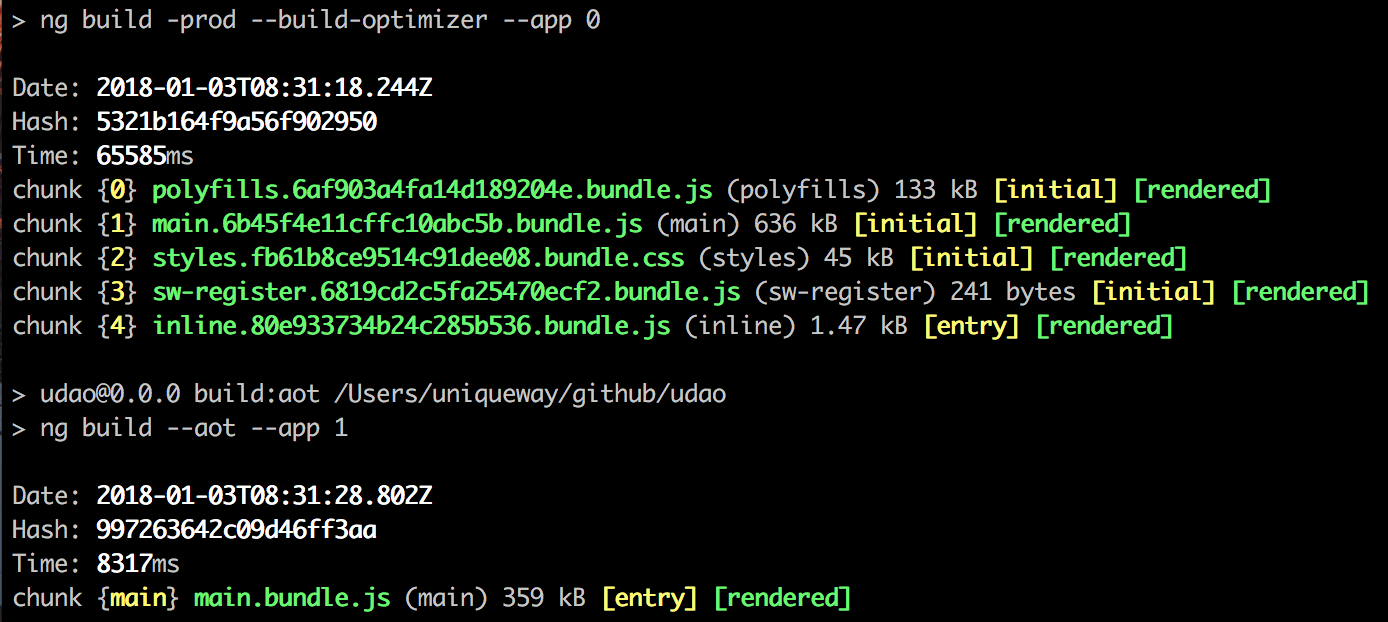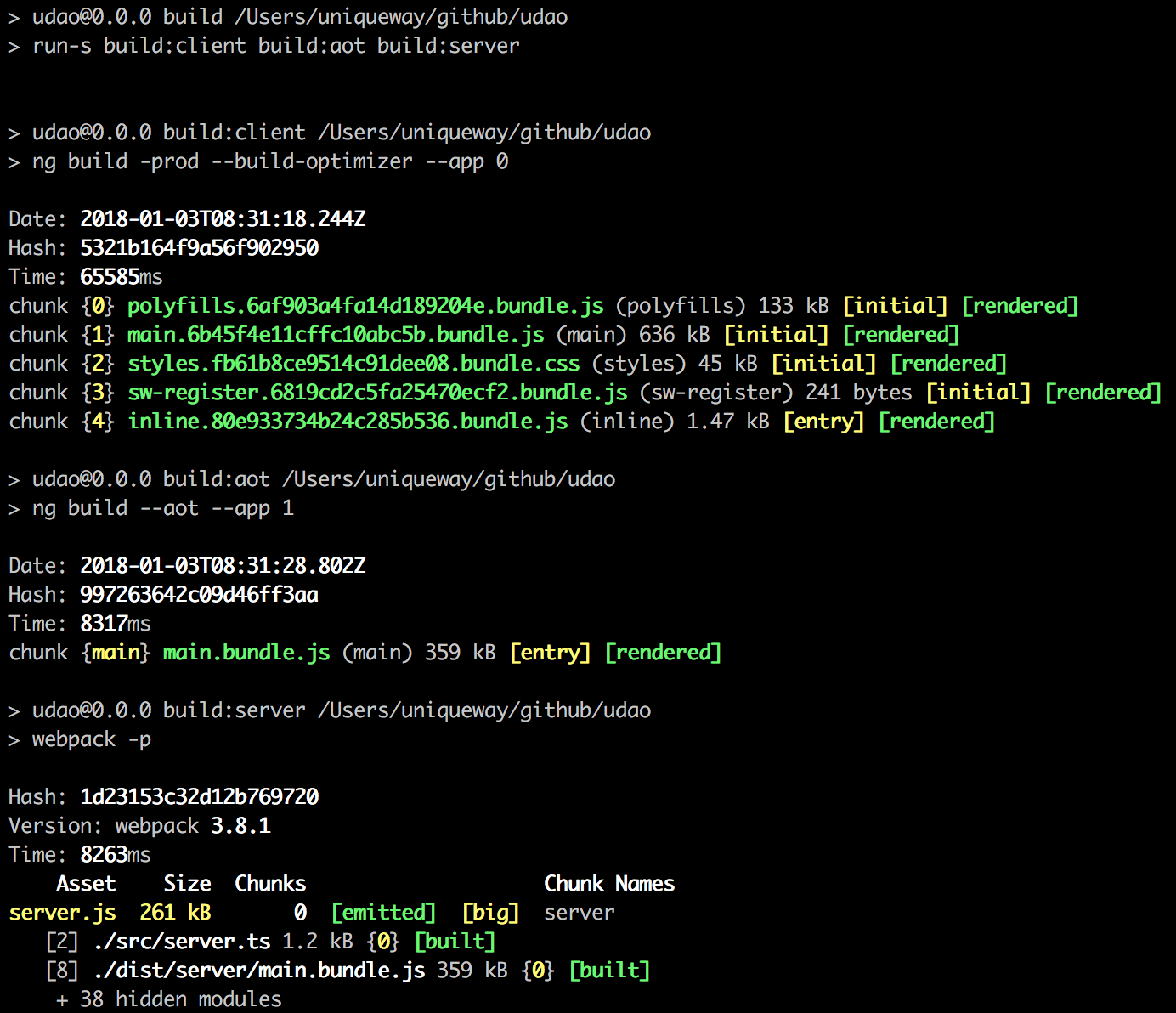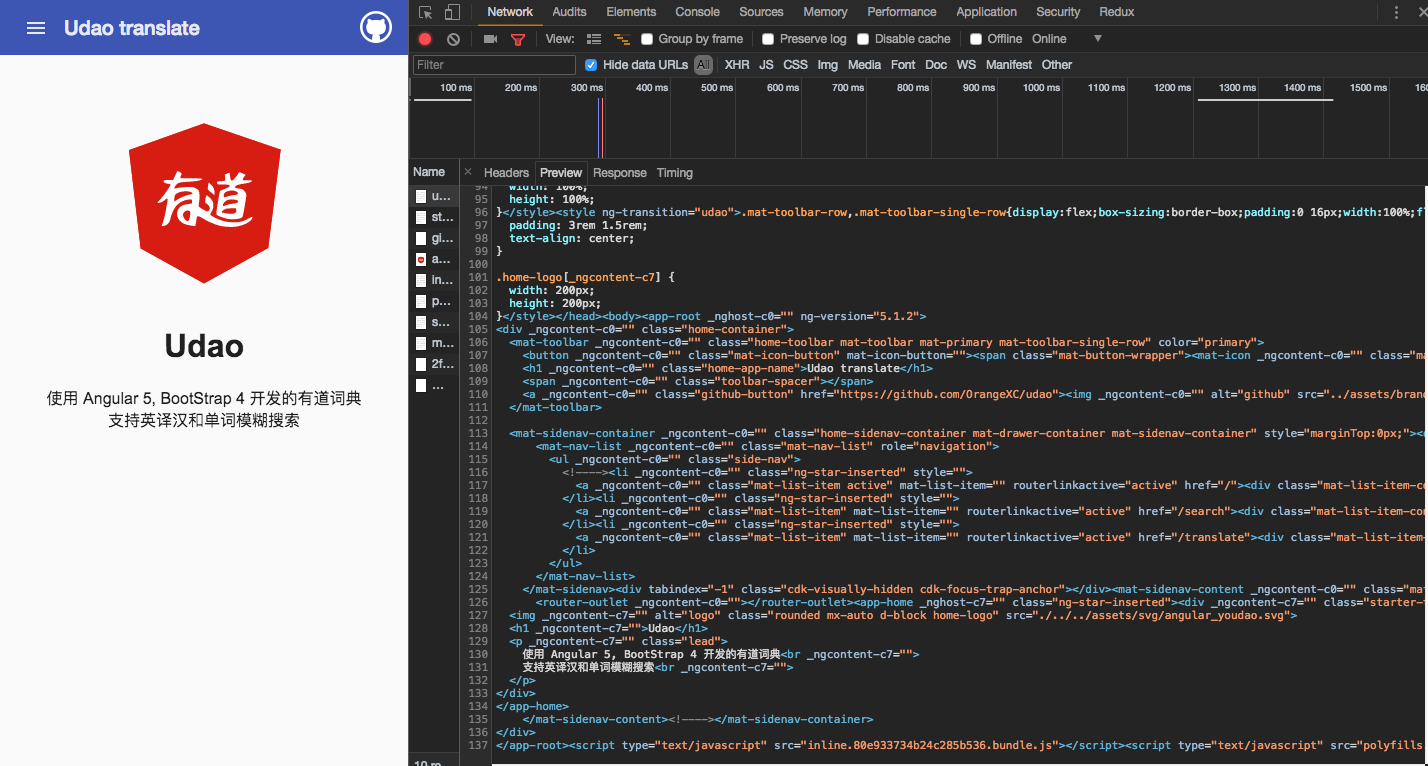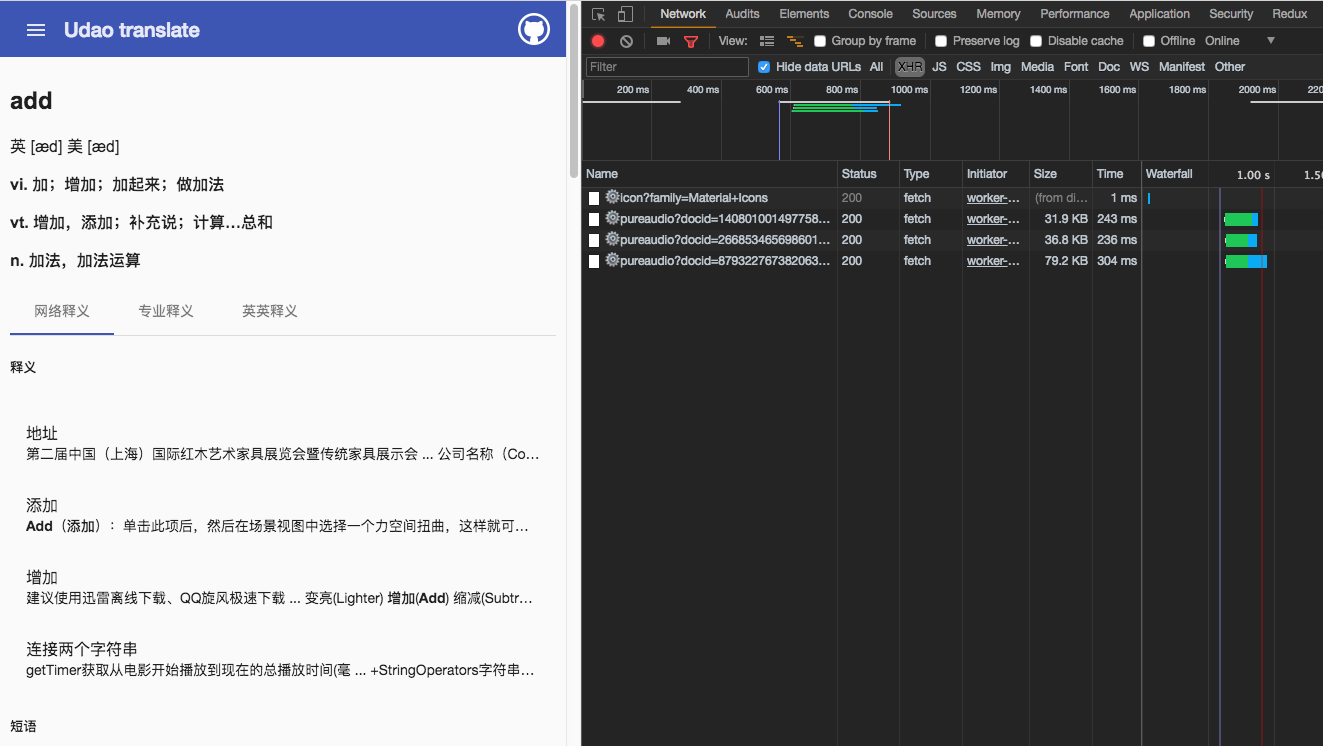
本文基于上一篇 Angular5 的文章继续进行开发,上文中讲了搭建 Angular5 有道翻译的过程,以及遇到问题的解决方案。
随后改了 UI,从 bootstrap4 改到 angular material,这里不详细讲,服务端渲染也与修改 UI 无关。
看过之前文章的人会发现,文章内容都偏向于服务端渲染,vue 的 nuxt,react 的 next。
在本次改版前也尝试去找类似 nuxt.js 与 next.js 的顶级封装库,可以大大节省时间,但是未果。
最后决定使用从 Angular2 开始就可用的前后端同构解决方案 Angular Universal(Universal (isomorphic) JavaScript support for Angular.)
在这里不详细介绍文档内容,本文也尽量使用通俗易懂的语言带入 Angular 的 SSR
前提
前面写的 udao 这个项目是完全遵从于 angular-cli 的,从搭建到打包,这也使得本文通用于所有 angular-cli 搭建的 angular5 项目。
搭建过程
首先安装服务端的依赖
yarn add @angular/platform-server express
yarn add -D ts-loader webpack-node-externals npm-run-all
这里需要注意的是
@angular/platform-server的版本号最好根据当前 angular 版本进行安装,如:@angular/platform-server@5.1.0,避免与其它依赖有版本冲突。
创建文件: src/app/app.server.module.ts
import { NgModule } from '@angular/core'
import { ServerModule } from '@angular/platform-server'
import { AppModule } from './app.module'
import { AppComponent } from './app.component'
@NgModule({
imports: [
AppModule,
ServerModule
],
bootstrap: [AppComponent],
})
export class AppServerModule { }
更新文件: src/app/app.module.ts
import { BrowserModule } from '@angular/platform-browser'
import { NgModule } from '@angular/core'
// ...
import { AppComponent } from './app.component'
// ...
@NgModule({
declarations: [
AppComponent
// ...
],
imports: [
BrowserModule.withServerTransition({ appId: 'udao' })
// ...
],
providers: [],
bootstrap: [AppComponent]
})
export class AppModule { }
我们需要一个主文件来导出服务端模块
创建文件: src/main.server.ts
export { AppServerModule } from './app/app.server.module'
现在来更新 @angular/cli 的配置文件 .angular-cli.json
{
"$schema": "./node_modules/@angular/cli/lib/config/schema.json",
"project": {
"name": "udao"
},
"apps": [
{
"root": "src",
"outDir": "dist/browser",
"assets": [
"assets",
"favicon.ico"
]
// ...
},
{
"platform": "server",
"root": "src",
"outDir": "dist/server",
"assets": [],
"index": "index.html",
"main": "main.server.ts",
"test": "test.ts",
"tsconfig": "tsconfig.server.json",
"testTsconfig": "tsconfig.spec.json",
"prefix": "app",
"scripts": [],
"environmentSource": "environments/environment.ts",
"environments": {
"dev": "environments/environment.ts",
"prod": "environments/environment.prod.ts"
}
}
]
// ...
}
上面的 // ... 代表省略掉,但是 json 没有注释一说,看着怪怪的....
当然 .angular-cli.json 的配置不是固定的,根据需求自行修改
我们需要为服务端创建 tsconfig 配置文件: src/tsconfig.server.json
{
"extends": "../tsconfig.json",
"compilerOptions": {
"outDir": "../out-tsc/app",
"baseUrl": "./",
"module": "commonjs",
"types": []
},
"exclude": [
"test.ts",
"**/*.spec.ts",
"server.ts"
],
"angularCompilerOptions": {
"entryModule": "app/app.server.module#AppServerModule"
}
}
然后更新: src/tsconfig.app.json
{
"extends": "../tsconfig.json",
"compilerOptions": {
"outDir": "../out-tsc/app",
"baseUrl": "./",
"module": "es2015",
"types": []
},
"exclude": [
"test.ts",
"**/*.spec.ts",
"server.ts"
]
}
现在可以执行以下命令,看配置是否有效
ng build -prod --build-optimizer --app 0
ng build --aot --app 1
运行结果应该如下图所示

然后就是创建 Express.js 服务, 创建文件: src/server.ts
import 'reflect-metadata'
import 'zone.js/dist/zone-node'
import { renderModuleFactory } from '@angular/platform-server'
import { enableProdMode } from '@angular/core'
import * as express from 'express'
import { join } from 'path'
import { readFileSync } from 'fs'
enableProdMode();
const PORT = process.env.PORT || 4200
const DIST_FOLDER = join(process.cwd(), 'dist')
const app = express()
const template = readFileSync(join(DIST_FOLDER, 'browser', 'index.html')).toString()
const { AppServerModuleNgFactory } = require('main.server')
app.engine('html', (_, options, callback) => {
const opts = { document: template, url: options.req.url }
renderModuleFactory(AppServerModuleNgFactory, opts)
.then(html => callback(null, html))
});
app.set('view engine', 'html')
app.set('views', 'src')
app.get('*.*', express.static(join(DIST_FOLDER, 'browser')))
app.get('*', (req, res) => {
res.render('index', { req })
})
app.listen(PORT, () => {
console.log(`listening on http://localhost:${PORT}!`)
})
理所当然需要一个 webpack 配置文件来打包 server.ts 文件: webpack.config.js
const path = require('path');
var nodeExternals = require('webpack-node-externals');
module.exports = {
entry: {
server: './src/server.ts'
},
resolve: {
extensions: ['.ts', '.js'],
alias: {
'main.server': path.join(__dirname, 'dist', 'server', 'main.bundle.js')
}
},
target: 'node',
externals: [nodeExternals()],
output: {
path: path.join(__dirname, 'dist'),
filename: '[name].js'
},
module: {
rules: [
{ test: /\.ts$/, loader: 'ts-loader' }
]
}
}
为了打包方便最好在 package.json 里面加几行脚本,如下:
"scripts": {
"ng": "ng",
"start": "ng serve",
"build": "run-s build:client build:aot build:server",
"build:client": "ng build -prod --build-optimizer --app 0",
"build:aot": "ng build --aot --app 1",
"build:server": "webpack -p",
"test": "ng test",
"lint": "ng lint",
"e2e": "ng e2e"
}
现在尝试运行 npm run build,将会看到如下输出:

node 运行刚刚打包好的 node dist/server.js 文件
打开 http://localhost:4200/ 会正常显示项目主页面

从上面的开发者工具可以看出 html 文档是服务端渲染直出的,接下来尝试请求数据试一下。
注意:本项目显式(菜单可点击)的几个路由初始化都没有请求数据,但是单词解释的详情页是会在
ngOnInit()方法里获取数据,例如:http://localhost:4200/detail/add直接打开时会发生奇怪的现象,请求在服务端和客户端分别发送一次,正常的服务端渲染项目首屏初始化数据的请求在服务端执行,在客户端不会二次请求!
发现问题后,就来踩平这个坑
试想如果采用一个标记来区分服务端是否已经拿到了数据,如果没拿到数据就在客户端请求,如果已经拿到数据就不发请求
当然 Angular 早有一手准备,那就是 Angular Modules for Transfer State
那么如何真实运用呢?见下文
请求填坑
在服务端入口和客户端入口分别引入 TransferStateModule
import { ServerModule, ServerTransferStateModule } from '@angular/platform-server';
// ...
@NgModule({
imports: [
// ...
ServerModule,
ServerTransferStateModule
]
// ...
})
export class AppServerModule { }
import { BrowserModule, BrowserTransferStateModule } from '@angular/platform-browser';
// ...
@NgModule({
declarations: [
AppComponent
// ...
],
imports: [
BrowserModule.withServerTransition({ appId: 'udao' }),
BrowserTransferStateModule
// ...
]
// ...
})
export class AppModule { }
以本项目为例在 detail.component.ts 里面,修改如下
import { Component, OnInit } from '@angular/core'
import { HttpClient } from '@angular/common/http'
import { Router, ActivatedRoute, NavigationEnd } from '@angular/router'
import { TransferState, makeStateKey } from '@angular/platform-browser'
const DETAIL_KEY = makeStateKey('detail')
// ...
export class DetailComponent implements OnInit {
details: any
// some variable
constructor(
private http: HttpClient,
private state: TransferState,
private route: ActivatedRoute,
private router: Router
) {}
transData (res) {
// translate res data
}
ngOnInit () {
this.details = this.state.get(DETAIL_KEY, null as any)
if (!this.details) {
this.route.params.subscribe((params) => {
this.loading = true
const apiURL = `https://dict.youdao.com/jsonapi?q=${params['word']}`
this.http.get(`/?url=${encodeURIComponent(apiURL)}`)
.subscribe(res => {
this.transData(res)
this.state.set(DETAIL_KEY, res as any)
this.loading = false
})
})
} else {
this.transData(this.details)
}
}
}
代码够简单清晰,和上面描述的原理一致
现在我们只需要对 main.ts 文件进行小小的调整,以便在 DOMContentLoaded 时运行我们的代码,以使 TransferState 正常工作:
import { enableProdMode } from '@angular/core'
import { platformBrowserDynamic } from '@angular/platform-browser-dynamic'
import { AppModule } from './app/app.module'
import { environment } from './environments/environment'
if (environment.production) {
enableProdMode()
}
document.addEventListener('DOMContentLoaded', () => {
platformBrowserDynamic().bootstrapModule(AppModule)
.catch(err => console.log(err))
})
到这里运行 npm run build && node dist/server.js 然后刷新 http://localhost:4200/detail/add 到控制台查看 network 如下:

发现 XHR 分类里面没有发起任何请求,只有 service-worker 的 cache 命中。
到这里坑都踩完了,项目运行正常,没发现其它 bug。
总结
2018 第一篇,目的就是探索所有流行框架服务端渲染的实现,开辟了 angular 这个最后没尝试的框架。
当然 Orange 还是前端小学生一枚,只知道实现,原理说的不是很清楚,源码看的不是很明白,如有纰漏还望指教。
最后 Github 地址和之前文章一样:https://github.com/OrangeXC/udao
Github 附有在线链接,好的就说到这了